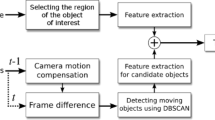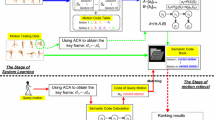Abstract
Due to its wide applications and importance in computer vision, motion detection has been receiving considerable attention from industry and academy. However, previous motion detection algorithms fail to achieve the flexibility and accuracy simultaneously for good detection results. In the present work, a scene-adaptive motion detection model based on machine learning and clustering technology is proposed. This model begins with training to the system by a group of testing images, in terms of various accurate parameters of one certain scene. Significant modifications have been reserved in the same area during motion detection, which are considered as a change clustering. Then, the model takes advantage of clustering technology to generate a minimum spanning tree (MST), which is one kind of average linkage clustering. The average shortest distance of the minimum spanning tree serves as a benchmark to identify the change in images. Finally the training parameters and detection algorithm are combined to monitor the scene. The clustering is introduced to this model during sample training, in order to obtain factors of higher quality followed by more accurate detection results. Finally, the experiment confirms the excellent adaptability and precision of the proposed motion detection model.











Similar content being viewed by others
References
Alpaydm E (2004) Introduction to machine learning. The MIT Press, MD
Barron JL, Fleet DJ, Beauchemin SS (1994) Performance of optical flow techniques. Int J Comput Vis 12:43–77
Bishop CM (2006) Pattern recognition and machine learning. Springer, MD
Chan PK, Mahoney MV, Arshad MH (2003) “A machine learning approach to anomaly detection.” Technical Report, CS-2003-06
Chaudhary A, Raheja JL, Das K, Raheja S (2011) Intelligent approaches to interact with machines using hand gesture recognition in natural way: a survey. Int J Comput Sci Eng Surv 2(1):122–133
Chen D, Yang J (2007) Robust object tracking via online dynamic spatial bias appearance models. IEEE Trans Pattern Anal Mach Intell 29(12):2157–2169
Comaniciu D, Meer P (2002) Mean shift: a robust approach toward feature space analysis. IEEE Trans Pattern Anal Mach Intell 24(5):603–619
Comanicu D, Ramesh V, Meer P (2000) “Real-time tracking of non-rigid objects using mean shift.” Proc of International Conference on Computer Vision and Pattern Recognition: 142–149
Cutler R, Davis L (1998) “View-based detection and analysis of periodic motion.” Proc. of the Fourteenth International Conference on Pattern Recognition(ICPR98) 1:495–500
Dixon KR, Lippitt CE, Forsythe JC (2005) “Supervised machine learning for modeling human recognition of vehicle-driving situation.” Proc. of the IEEE/RSJ International Conference on Intelligent Robots and Systems(IROS’05): 604–609
Dong H, Giakoumidis N, Juma JB, Tretyakov DA, Mavridis N (2012) A fast laser motion detection and approaching behavior monitoring method of moving object alarm system(MOAS). Procedia Eng 41:749–756
Elhabian SY, El-Sayed KM, Ahmed SH (2008) Moving object detection in spatial domain using background removal techniques–state-of-art. Recent Patents Comput Sci 1:32–54
Fablet R, Bouthemy P, Gelgon M (1999) “Moving object detection in color image sequences using region-level graph labeling.” Proc. of the IEEE International Conference on Image Processing(ICIP’99) 2:939–943
Fung G (2001) “A comprehensive overview of basic clustering algorithm”
Gall J, Yao A, Razavi N, Van Gool L, Lempitsky V (2011) Hough forests for object detection, tracking and action recognition. IEEE Trans Pattern Anal Mach Intell 33(11):2188–2202
Guanglong H, Shiyin Q (2012) High precision detection of a mobile object under dynamic imaging based on SURF and mean shift. CAAI Trans Intell Syst 7(1):61–68
Haritaoglu I, Harwood D, Davis LS (1998) “W4: who? when? where? what? a real time system for detecting and tracking people.” Proc. of the Third IEEE International Conference on Automatic Face and Gesture Recognition(ICAFGR’98): 222–227
Hu T, Zhu L (2010) “The moving detection algorithm based on clustering technology.” Proc. of the International Conference on Computer and Communication Technologies in Agriculture Engineering(CCTAE’10): 83–186
Jain R, Kasturi R, Schunck BG (1995) Machine vision. McGraw-Hill Inc, MD
Kentaro T, Krumm J, Brumitt B, Meyers B (1999) “Principles and practice of background maintenance.” Proc. of the Seventh IEEE International Conference on Computer Vision(ICCV’99) 1:255–261
Olson CF (1995) Parallel algorithm for hierarchical clustering. Parallel Comput 21(8):1313–1325
Piciarelli C, Foresti GL (2011) Surveillance-oriented event detection in video streams. Intell Syst 26(3):32–41
Richard J, Radke S, AI-Kofahi O, Roysam B (2005) Image change detection algorithms: a systematic survey. IEEE Trans Image Process 14(3):294–307
Scott DW (1992) Multivariate density estimation: theory, practice, and visualization. A Wiley-Interscience Publication, MD
Shafe AA, Hafz F, Ali MH (2009) Motion detection techniques using potical flow. World Acad Sci Eng Technol 32:559–561
Stenger B, Ramesh V, Paragios N, Coetzee F, Buhmann JM (2001) “Topology free hidden Markov models: application to back-ground modeling.” Proc. of the Eighth IEEE International Conference on Computer Vision(ICCV’01) 1:294–301
Witten I, Frank E (2005) Data mining. Morgan Kaufmann press, MD
Zhou Z, Niu B, Ke C, Wu W (2010) “Static object tracking in road panoramic videos.” Proc. of 2010 I.E. International Symposium on Multimedia: 57–64
Acknowledgments
This work was financially supported by the Program of Education Commission of Hubei Province, China (Grant No.Q20131904), the National Natural Science Foundation of China (Grant No. 61261016), the National Culture Promotion Project of China (Grant No.201307)and the Program of Ethnic and Religious Affairs Commission of Hubei Province, China (Grant No.HBMW2012006). Moreover, during the research, many valuable suggestions have been provided by Professor May Huang and Dr. Eric Chen, International Technological University, USA.
Author information
Authors and Affiliations
Corresponding author
Rights and permissions
About this article
Cite this article
Hu, T., Zheng, M., Li, J. et al. A scene-adaptive motion detection model based on machine learning and data clustering. Multimed Tools Appl 74, 2821–2839 (2015). https://doi.org/10.1007/s11042-013-1741-0
Published:
Issue Date:
DOI: https://doi.org/10.1007/s11042-013-1741-0




